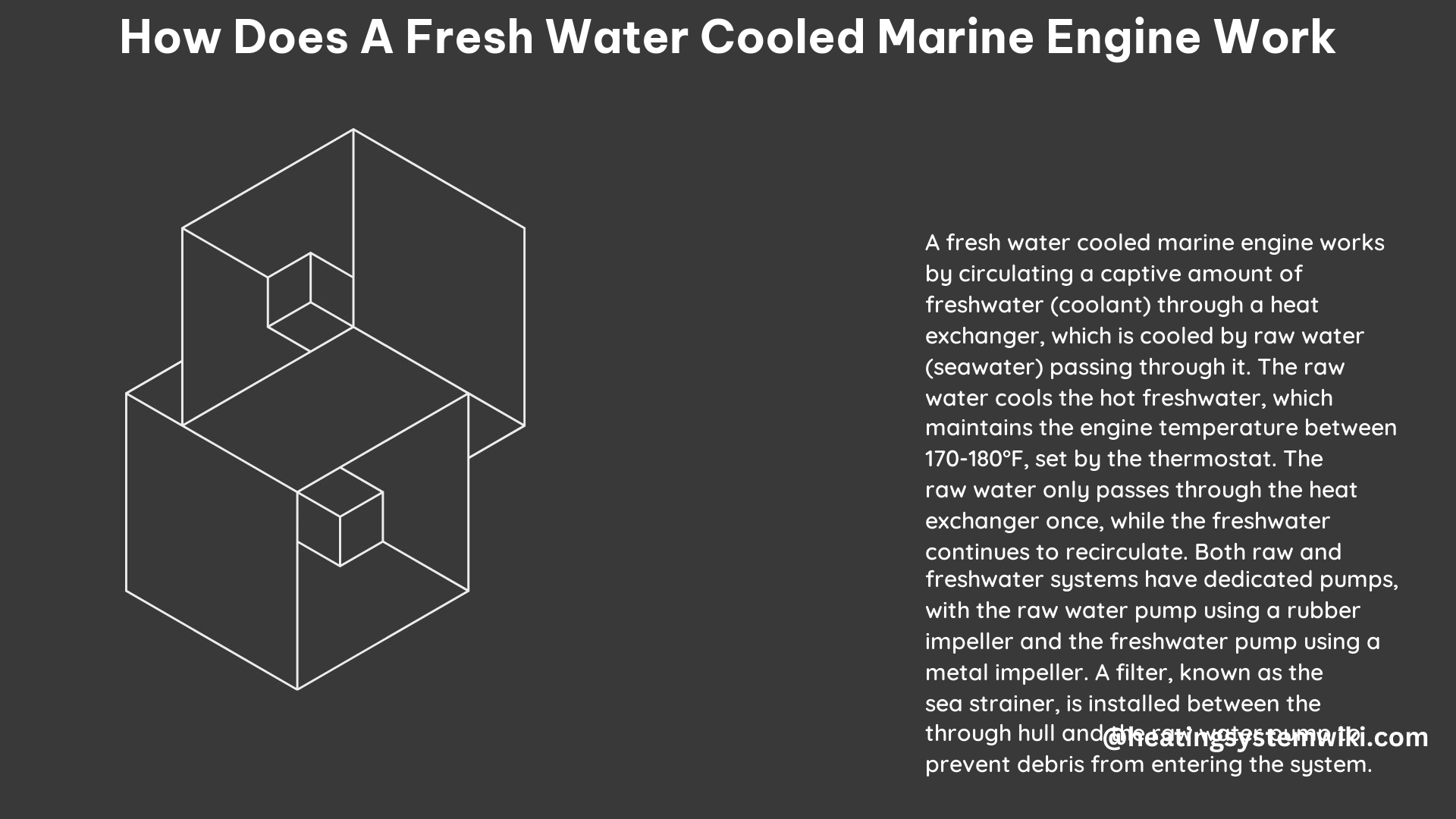A fresh water cooled marine engine works by circulating a captive amount of freshwater (coolant) through a heat exchanger that maintains the engine at a temperature set by the thermostat, usually between 170 and 180 degrees Fahrenheit. Unlike a car, a marine engine does not have a radiator since there is no air flow available to cool it. Instead, it utilizes the relatively cool seawater, described as raw water, to cool the fresh water.
The Cooling System Components
Fresh Water Pump
The fresh water pump is a metal impeller pump that circulates the fresh water (coolant) through the heat exchanger. It is typically made of cast iron or aluminum and has an impeller made of a durable material like bronze or stainless steel. The fresh water pump is designed to withstand the high temperatures and pressures of the engine cooling system.
Heat Exchanger
The heat exchanger is a device that uses the raw water to cool the fresh water. It consists of a series of coils or tubes filled with the fresh water (coolant) that are surrounded by the flowing raw water (seawater). The raw water absorbs the heat from the fresh water, effectively cooling the engine.
Heat exchangers come in various designs, such as tube-and-shell, plate-and-frame, or spiral-wound. The choice of heat exchanger depends on factors like the engine size, cooling capacity required, and space constraints on the boat.
Thermostat
The thermostat is a device that regulates the temperature of the engine by controlling the flow of fresh water through the heat exchanger. It is typically a wax-filled element that expands and contracts based on the temperature of the coolant.
When the engine is cold, the thermostat is closed, forcing the coolant to bypass the heat exchanger and recirculate back to the engine. As the engine warms up, the thermostat opens, allowing the coolant to flow through the heat exchanger and be cooled by the raw water.
The thermostat is usually set to open at a specific temperature, typically between 170 and 180 degrees Fahrenheit, to maintain the engine at the optimal operating temperature.
Sea Strainer
The sea strainer is a filter installed between the through-hull and the raw water pump. It prevents debris, such as seaweed, shells, or other foreign objects, from entering the raw water system and potentially clogging the heat exchanger or damaging the raw water pump.
The sea strainer is usually made of clear glass or plastic, allowing the skipper to visually inspect the filter and check for any debris buildup without having to open the housing.
Raw Water Pump
The raw water pump is a rubber impeller pump that circulates the raw water (seawater) through the heat exchanger. Unlike the fresh water pump, the raw water pump uses a rubber impeller to withstand the abrasive nature of the seawater.
The raw water pump is responsible for drawing the seawater from the through-hull and pushing it through the heat exchanger, where it absorbs the heat from the fresh water (coolant) and then discharges it overboard.
The Cooling Process

- The raw water pump draws seawater from the through-hull and pushes it through the heat exchanger.
- Inside the heat exchanger, the raw water flows around the coils or tubes filled with the fresh water (coolant) from the engine.
- The cold raw water absorbs the heat from the hot fresh water, effectively cooling the engine.
- The now-heated raw water is discharged overboard, while the cooled fresh water is circulated back to the engine by the fresh water pump.
- The thermostat regulates the flow of the fresh water through the heat exchanger, maintaining the engine at the optimal operating temperature.
Maintenance and Inspection
Regular maintenance and inspection of the fresh water cooled marine engine’s cooling system are crucial to ensure its proper operation and prevent overheating.
- Check the raw water flow: Upon engine startup, visually inspect the raw water discharge at the back of the boat to ensure the system is “pumping water.” This should be done for at least 2-3 discharges to confirm the system is primed and continues to pump water.
- Clean the sea strainer: Regularly check and clean the sea strainer to remove any debris that may have accumulated, which could restrict the flow of raw water.
- Inspect the heat exchanger: Periodically inspect the heat exchanger for any signs of corrosion, scale buildup, or blockages, and clean or replace it as necessary.
- Replace the impellers: The rubber impeller in the raw water pump and the metal impeller in the fresh water pump should be replaced at regular intervals, as specified by the manufacturer, to ensure reliable operation.
- Monitor the coolant level: Regularly check the fresh water (coolant) level in the system and top it up as needed to maintain the proper level.
By understanding the components and the cooling process of a fresh water cooled marine engine, boat owners and mechanics can effectively maintain and troubleshoot the system, ensuring the engine’s optimal performance and longevity.
Reference:
– Harbor Sailboats
– Club Sea Ray
– The Hull Truth
